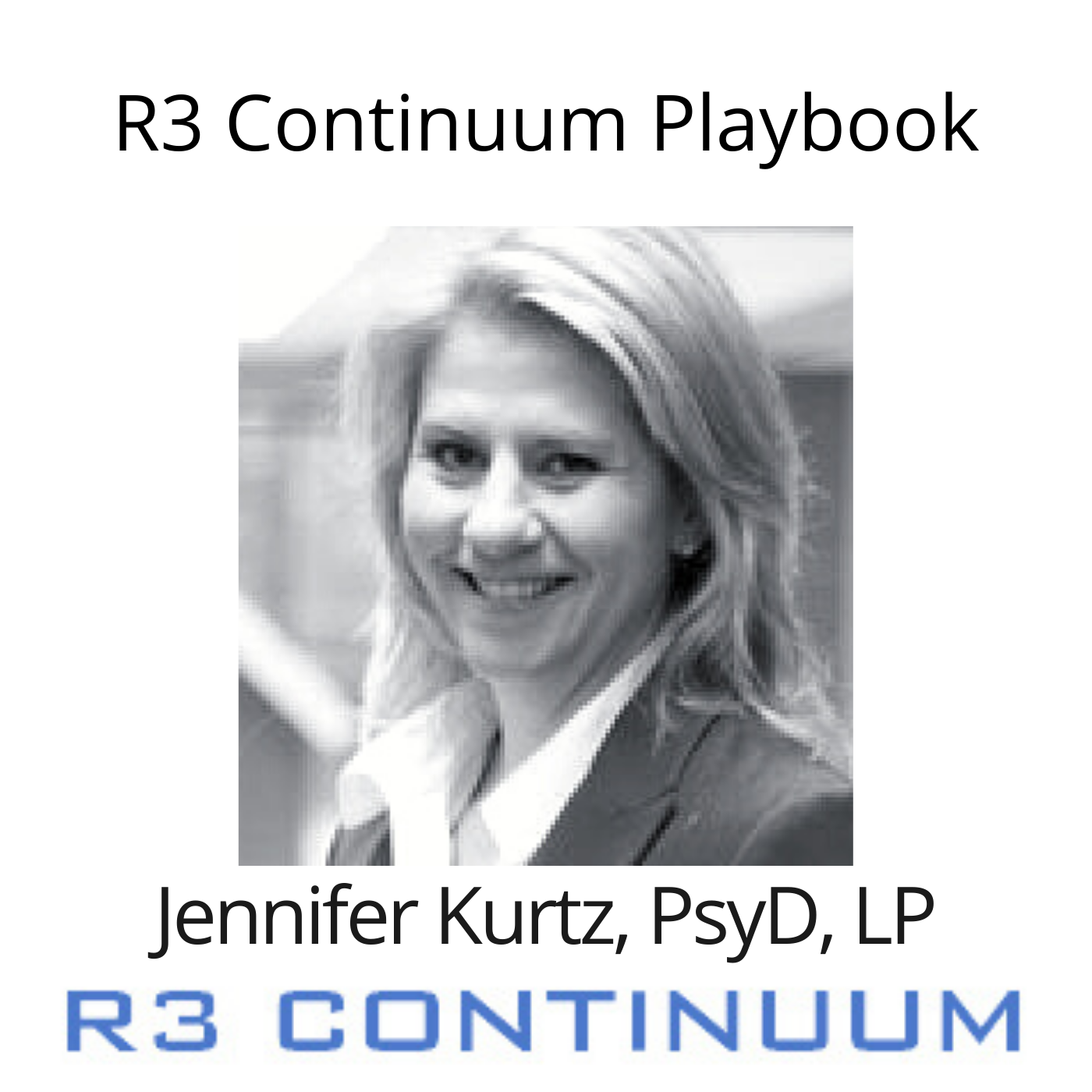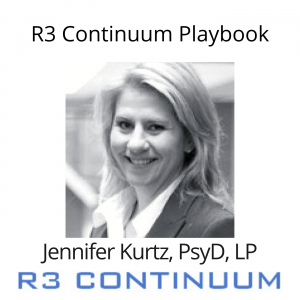
R3 Continuum Playbook: Workplace Violence Prevention
Dr. Jennifer Kurtz, Clinical Director over Fitness for Duty and Threat Consultation Services at R3 Continuum, presented a snapshot of the challenge of workplace violence, the training needed to prevent workplace violence, and the need for threat management teams in the workplace. The R3 Continuum Playbook is presented by R3 Continuum and is produced by the Minneapolis-St.Paul Studio of Business RadioX®. R3 Continuum is the underwriter of Workplace MVP, the show which celebrates heroes in the workplace.
TRANSCRIPT
Intro: [00:00:00] Broadcasting from the Business RadioX Studios, here is your R3 Continuum Playbook. Brought to you by Workplace MVP sponsor, R3 Continuum, a global leader in workplace behavioral health, crisis, and security solutions.
Jennifer Kurtz: [00:00:14] Hello. I’m Dr. Jennifer Kurtz, and I am the Clinical Director over Fitness for Duty and Threat Consultation Services at R3 Continuum. Today, I want to talk about an issue that keeps some employers up at night, workplace violence and how to prevent it. There’s roughly two million victims of workplace violence every year in the United States. Just this year, just recently, on June 15th in Albertville, Alabama, Andreas Horton, a longtime employee of the Mueller Water Products factory, shot and killed two and injured another two. After, another Mueller company, the Henry Pratt facility in Aurora, Illinois, had an employee kill five just 28 months earlier.
Jennifer Kurtz: [00:01:04] On May 26th of this year in San Jose, California at the Santa Clara Valley Transit Authority, a transit worker named Samuel James Cassidy, who was an employee for over a decade, shot and killed nine. And on April 15th, at a FedEx warehouse in Indianapolis, Indiana, a former employee, Brandon Scott Hole, killed eight and wounded five. These are examples that have happened just in the past three months, and they don’t even include five mass shootings that occurred in just the last week of June alone in two parking lots, two nightclubs, and an American Legion that was hosting a party for teenagers. Those occurred just in one week in June.
Jennifer Kurtz: [00:02:00] According to the U.S. Department of Labor, in 2019, which is the most recent year for which we have this kind of data, there were 5,333 workplace fatalities, 16 percent of which were due to workplace violence. Contrary to popular opinion, people do not just snap. There are always warning signs that a violent act might be coming soon. You just have to know what to look for. And if you do know what to look for, many times these violent acts can be prevented.
Jennifer Kurtz: [00:02:36] You just don’t usually hear about all the mass violence plans that get prevented or that never take place. For example, Eric Lin in Miami, Florida. He was a man who had been stalking and harassing a restaurant employee. And he was ultimately prevented from kidnapping that employee. Or Rodolfo Montoya in Long Beach, California. He was a hotel cook who was unhappy with the decision H.R. had made, and he had planned to shoot people as they came into the hotel lobby. Or Paul Stieber in High Point, North Carolina. He had planned to kill people at High Point University by a deadline of Christmas 2019 because he was tired of feeling like an outcast.
Jennifer Kurtz: [00:03:30] These potential tragedies were averted because employees, and employers, students, and law enforcement were all trained in recognizing risk factors and warning signs. They knew how and when to report their concerns. There were systems by which to document the reports and monitor the cases. And law enforcement and the appropriate external resources were brought in at the right time so that nobody got hurt.
Jennifer Kurtz: [00:04:07] Now, despite how successful these comprehensive workplace violence prevention programs are, 70 percent of workplaces don’t have one. Now, having a workplace violence prevention program is critical in this day and age to keep your employees safe. Developing a comprehensive plan will include multiple steps.
Jennifer Kurtz: [00:04:37] And one key aspect of a successful program is education. And there’s multiple components to the education needed. Everyone in the company is going to need to receive education, every employee, every manager, every executive, and even the owner. Education in what exactly workplace violence is and how prevalent it is. Education about what the risk factors are for workplace violence. Education about what to look for, that would indicate violence might be coming soon, which are the warning signs of workplace violence.
Jennifer Kurtz: [00:05:19] Everyone’s also going to need to be taught what factors protect against violent behavior and lower the risk of violent behavior. They’ll need to learn how to intervene, if possible and safe. And how and when to report their concerns that someone might be dangerous or become violent. Education is also going to likely need to include training and special topics related to workplace violence, like hostility de-escalation, threat assessment and management, active shooter training, threat assessment team training, situational awareness. And special situational topics, like bullying and harassment, or stalking, and domestic violence, suicide prevention, or legal defensibility when related to managing these kinds of behaviors, lone actor terrorism, and other related subjects.
Jennifer Kurtz: [00:06:29] Managers and executives will also need additional customized education related to the development and functioning of a threat management team. There should be an internal threat management team whose job is going to be to investigate and monitor any reported concerns or potentially threatening individuals. This team would be made of staff from multiple disciplines and departments within the company. And, ideally, would also include external subject matter expert consultants when appropriate, such as law enforcement, executive protection agents, legal counsel, and forensic behavioral experts.
Jennifer Kurtz: [00:07:14] To be consistent with the industry’s best practice for workplace violence prevention, the threat management team would need to create clear corporate policies on workplace violence, what will and won’t be tolerated, the consequences for violating these policies. An anonymous reporting structure for employees to provide information when they have concerns about potential violence. The information reported must be kept in a fashion that allows the stakeholders access so that there’s no issues with some people having needed information and other people not having the needed information so something doesn’t get missed.
Jennifer Kurtz: [00:07:59] But at the same time, this method of data collection and storing the data needs to be kept confidential so that only members of the threat management team and the necessary external resources have access to it in order to protect the employee’s privacy. Management also is going to need to be aware of what barriers there are to successful programs like this and implement programs and policies to address those barriers.
Jennifer Kurtz: [00:08:34] So, for example, one barrier to education about workplace violence is stigma, stigma associated with mental health problems. Nobody wants to talk about it or a lot of people really don’t want to talk about it. So, management can look at promoting company activities to fight the stigma of mental health problems to try to counteract the barrier. That would be an example of a proactive strategy or preventive strategy to a successful workplace violence prevention program.
Jennifer Kurtz: [00:09:13] Another way is they could promote activities or even social activities to counter isolation and try to foster connectedness between employees, and the people, and the company. They should also encourage an environment of acceptance amongst employees and, above all, respectful treatment. These are all examples of activities that aim to reduce some of the known risk factors of workplace violence and attempt to encourage or cultivate known protective factors against workplace violence.
Jennifer Kurtz: [00:09:54] Additionally, best-practice programs to prevent violence at work include a concerted focus on identifying those who may be at risk and attempting to provide resources before a problem starts. So, accessibility to quality mental health resources is absolutely crucial to a successful program, such as round-the-clock EAP services and a health insurance plan with good mental health service coverage. They should also be providing other resources that reduce common sources of daily stress for employees, such as financial planning seminars, or resources for quality child care, or resiliency training are good examples. These kinds of additional life stressor resources are also invaluable to these kinds of programs.
Jennifer Kurtz: [00:10:57] And then, of course, these programs are going to need to have a worst case scenario plan. What is the plan if your worksite has an active shooter? What do you do? What do the employees do? Where do they go? What are the escape routes? How does the information get communicated to everybody that there’s a shooter? How are people going to be accounted for when everybody gets out of the building? Who’s responsible for that? Where are the meeting spots?
Jennifer Kurtz: [00:11:31] The point is to have a plan. You need to have a plan. And then, you have to train everybody to the plan. And then, you have to practice it, and practice it, and practice it, and then you practice it some more. You need to have everybody very, very comfortable with knowing exactly what they need to do and what their responsibilities are.
Jennifer Kurtz: [00:11:55] We just don’t work in the same world we did 30 years ago. Workplace violence is no longer something that employers can just hope doesn’t happen. It’s time to be prepared. If you want to be prepared with help from experts in the industry, R3 Continuum can help. We can provide a variety of customized services to provide you with tailored solutions to keep your employees and your worksite safe. For more information, contact us at info@r3c.com.
Show Underwriter
R3 Continuum (R3c) is a global leader in workplace behavioral health and security solutions. R3c helps ensure the psychological and physical safety of organizations and their people in today’s ever-changing and often unpredictable world. Through their continuum of tailored solutions, including evaluations, crisis response, executive optimization, protective services, and more, they help organizations maintain and cultivate a workplace of wellbeing so that their people can thrive. Learn more about R3c at www.r3c.com.
R3 Continuum is the underwriter of Workplace MVP, a show which celebrates the everyday heroes–Workplace Most Valuable Professionals–in human resources, risk management, security, business continuity, and the C-suite who resolutely labor for the well-being of employees in their care, readying the workplace for and planning responses to disruption.
Connect with R3 Continuum: Website | LinkedIn | Facebook | Twitter















